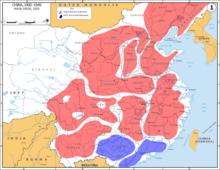
Back عصر أمراء الحرب Arabic Ера на местните военачалници Bulgarian Krigsherre-tiden Danish Warlord-Ära German Era de los señores de la guerra Spanish دوره جنگسالاران Persian Sotaherrojen aikakausi Finnish Seigneurs de la guerre chinois French תקופת המצביאים HE Hadurak kora Hungarian
| Warlord Era | |||||||||||||||||||||||||
|---|---|---|---|---|---|---|---|---|---|---|---|---|---|---|---|---|---|---|---|---|---|---|---|---|---|
 Major Chinese warlord coalitions in 1925. The blue area was controlled by the Kuomintang, which later formed the Nationalist government in Canton. | |||||||||||||||||||||||||
| Traditional Chinese | 軍閥時代 | ||||||||||||||||||||||||
| Simplified Chinese | 军阀时代 | ||||||||||||||||||||||||
| |||||||||||||||||||||||||
| History of the Republic of China |
|---|
 |
|
|
The Warlord Era was a period in the history of the Republic of China when control of the country was divided among former military cliques of the Beiyang Army and other regional factions from 1916 to 1928.
In historiography, the Warlord Era began in 1916 upon the death of Yuan Shikai, the de facto dictator of China after the Xinhai Revolution overthrew the Qing dynasty and established the Republic of China in 1912. Yuan's death created a power vacuum that spread across the regions of Sichuan, Shanxi, Qinghai, Ningxia, Guangdong, Guangxi, Gansu, Yunnan and Xinjiang. The Nationalist Kuomintang government of Sun Yat-sen based in Guangzhou began to contest Yuan's Beiyang government based in Beijing as to which was the legitimate government of China. The Warlord Era was characterized by constant civil war between different factions, the largest of which was the Central Plains War (1929–1930) which involved more than one million soldiers.[1]
After the death of Yuan Shikai, he was succeeded by Li Yuanhong as president, Duan Qirui as premier, and Feng Guozhang as vice president, but they could not agree over the division of powers between their offices, and Feng also rivaled Duan for control over Yuan's Beiyang Army. This led the Beiyang government to be split between two factions, Duan's Anhui clique and Feng's Zhili clique. In the summer of 1917 Li tried to remove Duan from the premiership, and another general, Zhang Xun, arrived in Beijing to mediate their dispute. He instead forced Li to resign and made a brief attempt to restore the Qing dynasty, before Duan's troops arrived in the capital to end the restoration. Afterwards, Feng became acting president because of Li's resignation, but the real power was held by Duan, who made Feng step down in late 1918. Feng died not long after, but in mid-1920 the new head of the Zhili clique, Cao Kun, led his forces to defeat Duan in the Zhili–Anhui War, in an alliance with Zhang Zuolin of the Fengtien clique. A power struggle then broke out between Cao and Zhang, which ended in Cao defeating Zhang in the First Zhili–Fengtian War, in 1922. He remained in control until 1924, when during the Second Zhili–Fengtian War, he was betrayed by his subordinate Feng Yuxiang, who joined Zhang and staged a coup against Cao. The two of them shared power for one year, and also brought back Duan Qirui to serve as president, before Zhang decided to remove both of them, with the help of Cao's former subordinate, Wu Peifu. Zhang Zuolin then led the Beiyang government until 1928.[2][3]
The warlords of the southern provinces of China cooperated against Yuan's dictatorship and then Duan Qirui's attempt to extend Beiyang control into the south, but they were also divided between the Yunnan, Guangxi, Guizhou, and Sichuan cliques.[4][5] Sun Yat-sen created an alternative government in Guangzhou (Canton) to oppose the Beiyang warlords, but it only had local support in Guangdong, and not of the other leaders in the south.[6] Lu Rongting's Guangxi clique rivaled Sun for control over the Guangzhou government,[7] and their dispute led to Sun and his Kuomintang supporters abandoning it in 1918. The southern government held a peace conference with Beiyang representatives, but no agreement could be reached. In 1920 the warlord Chen Jiongming invaded Guangdong and ended Lu's control there in the Guangdong–Guangxi War, after which Sun returned. But they disagreed on strategy, with Chen not wanting to invade the north, and their disagreement led to Chen turning on Sun.[8] The Yunnan warlords intervened to back Sun Yat-sen, defeating his rival, but caused Sun to become dependent on their support. To resolve this problem he accepted Soviet assistance in building a party and military infrastructure of his own, creating the Whampoa Military Academy and the National Revolutionary Army. After Sun died in 1925, the head of the Whampoa Academy, Chiang Kai-shek, emerged as the military leader of the KMT party.[9]
The Warlord Era formally ended in 1928 when the Kuomintang under Chiang Kai-shek officially unified China through the Northern Expedition, marking the beginning of the Nanjing decade. However, several of the warlords continued to maintain their influence throughout the 1930s and the 1940s, which was problematic for the Nationalist government during both the Second Sino-Japanese War and Chinese Civil War.
- ^ Min, Mao (2017). The Revival of China, Volume 1. CreateSpace Independent Publishing Platform. p. 126. ISBN 9781976739583.
- ^ Rhoads, Edward J. M. (2000). Manchus and Han: Ethnic Relations and Political Power in Late Qing and Early Republican China, 1861–1928. Seattle: University of Washington Press. pp. 239–242, 247, 250. ISBN 978-0-295-99748-3.
- ^ McCord 1993, pp. 246–250.
- ^ McCord 1993, pp. 245–250.
- ^ McCord 1993, p. 288.
- ^ McCord 1993, p. 254.
- ^ McCord 1993, p. 295.
- ^ Zhao, Xuduo (2023). Heretics in Revolutionary China: The Ideas and Identities of Two Cantonese Socialists, 1917–1928. Germany: Brill. pp. 73–74, 112–114. ISBN 9789004547148.
- ^ Jordan, Donald A. (1976). The Northern Expedition: China's National Revolution of 1926–1928. University of Hawaii Press. pp. 4–6, 32–39. ISBN 9780824880866.
© MMXXIII Rich X Search. We shall prevail. All rights reserved. Rich X Search